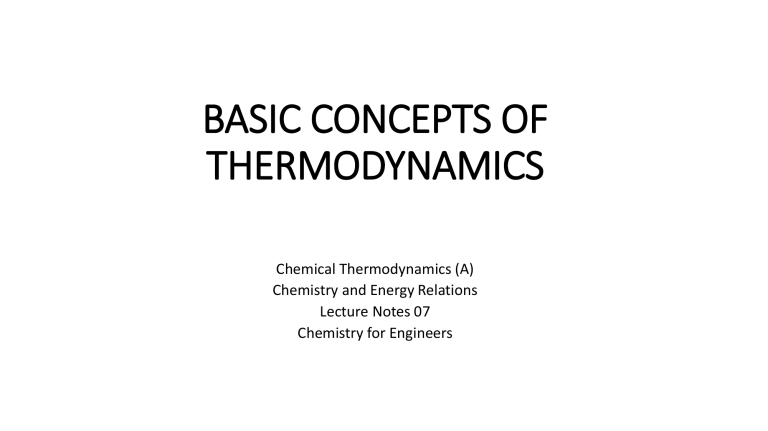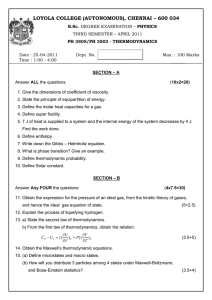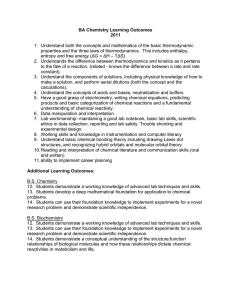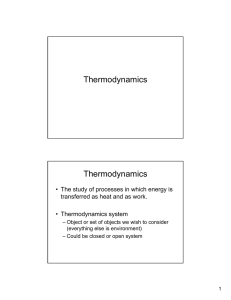
BASIC CONCEPTS OF THERMODYNAMICS Chemical Thermodynamics (A) Chemistry and Energy Relations Lecture Notes 07 Chemistry for Engineers BASIC CONCEPTS OF THERMODYNAMICS INTRODUCTION THERMODYNAMICS is the study of the interrelation of various forms of energy. It came from the Greek words “therme” (heat) and “dy’namis” (power). CHEMICAL THERMODYNAMICS is the study of the interrelation between heat and work with chemical reactions or with physical changes of states within the scope of the laws of thermodynamics. CHEMICAL ENERGY is the energy stored in all substances which appears when the substances undergo transformation. BASIC CONCEPTS OF THERMODYNAMICS THERMODYNAMIC SYSTEMS SYSTEM – is defined as any part of the universe that is chosen for a study and is confined in an inert container, which can either be real or imaginary, to separate it from the rest of the universe SORROUNDINGS – is the rest of the universe that isn’t defined as the system boundary surroundings system BASIC CONCEPTS OF THERMODYNAMICS CLASSIFICATIONS OF SYSTEM 1. ISOLATED – a system that is not capable of exchanging neither matter nor energy with the rest of the universe 2. CLOSED – a system that is capable of exchanging only energy but not matter with the surroundings 3. OPEN – a system that is capable of exchanging both matter and energy across the boundary BASIC CONCEPTS OF THERMODYNAMICS PHASES OF A SYSTEM PHASE – is defined as a homogeneous, physically distinct and mechanically separable portion of a system HOMOGENEOUS SYSTEM – a system that consists of only one phase HETEROGENEOUS SYSTEM – a system consisting of two or more phases BASIC CONCEPTS OF THERMODYNAMICS PROPERTIES OF A SYSTEM PROPERTY – a characteristic which can be quantitatively evaluated or a characteristic quality of the system which depends on the final system. Examples are pressure, temperature, energy GENERAL CLASSES OF THERMODYNAMIC PROPERTIES 1. Extensive properties – those that are dependent on the mass of the system 2. Intensive property – those that are independent on the mass of the system BASIC CONCEPTS OF THERMODYNAMICS THERMODYNAMIC STATES AND PROCESSES THERMODYNAMIC PARAMETERS – are measurable physical characteristics of a system that enable us to define the system itself (composition, volume, temperature, pressure) STATE OF A SYSTEM – is the system’s condition described or measured by a set of thermodynamic variables. It changes when one or more of its thermodynamic variables undergo(es) change(s) STATE FUNCTION – a thermodynamic property which depends only on the state of the system but not on the paths followed by the system during the change. Examples are changes in internal energy, enthalpy, entropy and free energy. EQUILIBRIUM STATE – a system with fixed composition, a uniform temperature of the system and with its surroundings, and with no unbalanced force within the system and the system and its surroundings. PATH is a locus of series of states through which a system passes between initial and final states. PROCESS is the transformation of a thermodynamic system from one thermodynamic state to another BASIC CONCEPTS OF THERMODYNAMICS TYPES OF PROCESSES Isothermal – occurs when the change of the system occurred at constant temperature Isobaric – occurs when the change of the system is observed but the operation was carried out at constant pressure Isochoric – occurs when the change of the system took place under a constant volume Adiabatic – occurs when the change in the system occurred without an exchange of heat with the surroundings but the temperature of the system changes. Isentropic – the entropy remains constant during the process Isenthalpic – the enthalpy remains constant during the process BASIC CONCEPTS OF THERMODYNAMICS CLASSIFICATIONS OF PROCESSES Non-flow process – a process undergone by fluid in a closed system Flow process – a process undergone by a fluid in an open system Reversible process – a process in which the energy change in every step of the process can be reversed in direction by an infinitesimal change in any of the variables acting on the system. A process can be made reversible by performing the change very slowly with no friction and no finite temperature differences. Irreversible process – a process in which the system and the surrounding after undergoing changes cannot get back to their initial state and tend to proceed to a different direction but cannot proceed to the reverse direction BASIC CONCEPTS OF THERMODYNAMICS DIMENSIONS OF UNITS QUANTITY SI UNIT ENGLISH UNIT Length meters (m) foot (ft) Mass kilogram (kg) pound mass (lbm) Time second (s) second (s) Temperature Kelvin (K) Rankine (R) Volume cubic meter (m3) cubic feet (ft3) Pressure Pascal (Pa) pound per square inch (psi) Force Newton (N) pound force (lbf) Energy Joules (J) foot-pound force (ft-lbf) BASIC CONCEPTS OF THERMODYNAMICS COMMON CONVERSION FACTORS BASIC CONCEPTS OF THERMODYNAMICS COMMON CONVERSION FACTORS BASIC CONCEPTS OF THERMODYNAMICS COMMON CONVERSION FACTORS BASIC CONCEPTS OF THERMODYNAMICS BASIC CONCEPTS OF THERMODYNAMICS DENSITY, SPECIFIC VOLUME AND SPECIFIC WEIGHT Density of a substance is the ratio of the mass to the volume of the substance Specific volume of a substance is the ratio of the volume to the mass of the substance Specific weight of a substance is the ratio of the weight to the volume of a substance Specific gravity (relative density) of a liquid is the ratio of density of the liquid to the density of water at a specified temperature Specific gravity (relative density) of a gas is the ratio of the density of air to the density of water at a specified temperature and pressure BASIC CONCEPTS OF THERMODYNAMICS TEMPERATURE Temperature is the measure of the coldness or warmth of a substance Absolute temperature is the temperature measured using a scale beginning at zero, with that zero being the coldest theoretically attainable in nature. Boiling point – the state wherein the liquid and the gaseous phases of a substance is at equilibrium Melting point – the state wherein the solid and the liquid phases of a substance is at equilibrium Triple point – the state wherein all three phases (solid, liquid and gas) of a substance coexist simultaneously (Triple point of water is 0.01°C) BASIC CONCEPTS OF THERMODYNAMICS TEMPERATURE: the measure of the coldness or warmth of a substance BASIC CONCEPTS OF THERMODYNAMICS PRESSURE Pabsolute = Pgauge + Patmospheric BASIC CONCEPTS OF THERMODYNAMICS ENERGY ENERGY is defined as the capacity or ability to do work. POTENTIAL ENERGY of a system is a result to its elevation in a gravitational field. PE = mgh KINETIC ENERGY of a system is a result of motion relative to some reference KE = ½ mv2 INTERNAL ENERGY of a system is the energy stored within the body resulting from the kinetic and potential energy in molecules. U = PE + KE BASIC CONCEPTS OF THERMODYNAMICS ENERGY MECHANICAL ENERGY is a form of energy that can be converted directly and completely into mechanical work by an ideal mechanical device such as an ideal pump or turbine. ENTHALPY of a system is the energy that is equivalent to the sum of the internal energy of the system and the product of the pressure and the volume H = U + PV HEAT is a form of energy that flows between two systems by virtue of a temperature difference between them. BASIC CONCEPTS OF THERMODYNAMICS WORK WORK is the energy transfer associated with force acting through a distance TYPES OF WORK 1. Electrical work is the work done on a charged particle by an electric field Welectrical = VI∆t 2. Mechanical work is the amount of energy transferred by a force or the work done by a system W = Fd BASIC CONCEPTS OF THERMODYNAMICS 3. Moving boundary work occurs when the mass of the substance contained within the system boundary causes force to act on the boundary surface and make it move W = p∫dV 4. Gravitational work is the work done against the force of gravity W= mg 5. Acceleration work is the work associated with change in the velocity of a system W = 1/2m (v22 -v12) 6. Shaft work is the work done with energy transmission with a rotating shaft 7. Spring work is the work done by a spring as a result of the application of force to it BASIC CONCEPTS OF THERMODYNAMICS SAMPLE PROBLEMS 1. Carry out the following conversions of energy units: (a) 14.3 BTU into cal, (b) 1.4 x105 cal into joules, (c) 31.6 mJ into BTU 2. Make the following conversions: (a) 72°F to °C; (b) 216°C to °F; (c) 233°C to K; (d) 315K to °F; (e) 0K to °F 3. Suppose you decide to define your own temperature scale using the freezing point (13°C) and boiling point (360°C) of oleic acid, the main component of olive oil. If you set the freezing point of oleic acid as 0°O and the boiling point as 100°O, what is the freezing point and boiling point of water on this new scale? BASIC CONCEPTS OF THERMODYNAMICS SAMPLE PROBLEMS 4. The density of air at ordinary atmospheric pressure and 25°C is 1.19 g/L. What is the mass, in kilograms, of the air in a room that measures 14.5 ft x 16.5 ft x 8.0 ft. 5. (a) A sample of tetrachloroethylene, a liquid used in dry cleaning that is being phased out because of its potential to cause cancer, has a mass of 40.55g and a volume of 25.0mL at 25°C. What is its density at this temperature? (b) Carbon dioxide is a gas at room temperature and pressure. However, carbon dioxide can be put under pressure to become supercritical fluid that is much safer dry-cleaning agent than tetrachloroethylene. At a certain pressure, the density of supercritical CO2 is 0.469 g/cm3. What is the mass of a 25.0mL sample of supercritical CO2 at this pressure? BASIC CONCEPTS OF THERMODYNAMICS SAMPLE PROBLEMS 6. An astronaut weighs 739N in Houston, Texas, where the local acceleration of gravity is g = 9.793 m/s2. What are the astronaut’s mass and weight in the moon where g = 1.67 m/s2? 7. A dead-weight gauge with a 1-cm diameter piston is used to measure pressures very accurately. In a particular instance, a mass of 6.14kg (including piston and pan) brings it into balance. If the local acceleration of gravity is 9.82 m/s2, what is the gauge pressure being measured? If the barometric pressure is 748 torr, what is the absolute pressure? 8. At 27°C, the reading on a manometer filled with mercury is 60.5 cm. The local acceleration of gravity is 9.784 m/s2. To what pressure does this height of mercury correspond? Express answer in bar. Density of mercury at 27°C is 13.53g/cm3. BASIC CONCEPTS OF THERMODYNAMICS SAMPLE PROBLEMS 9. A fluid has a density of 920 kg/m3. What is the specific gravity of the fluid? 10. A condenser vacuum gauge read 580 mmHg when the barometer reads 760 mmHg. Determine the absolute condenser pressure in bars. 11. The initial pressure and volume in a piston-cylinder arrangement are 300 kPa and 2m3, respectively. Energy is added to the system and the piston is withdrawn in such a way that the quantity PV remains constant. If the final pressure is 100 kPa, find the work done by the gas on the piston. BASIC CONCEPTS OF THERMODYNAMICS REFERENCES Brown, T.L., Lemay Jr., H.E., Bursten, B.E., Murphy, C.J., and Woodward, P.M. (2012) Chemistry: The Central Science, 12th Ed., USA: Pearson Education, Inc. Brown, L.S. and Holme, T.A. (2011) Chemistry for Engineering Students, 2nd Edition, USA, Brooks/Cole, Cengage Learning Chang, R. (2010) Chemistry, 10th Ed., New York, McGraw Hill Maron, S.H and Lando, J.B. (1974) Fundamentals of Physical Chemistry. Macmillan Publishing Co. Inc. New York, USa Smith, J.M., Van Ness, H.C., Abbot, M.M. (1996) Introduction to Chemical Engineering Thermodynamics, 5th Ed., McGraw Hill International Editions, Chemical Engineering Series, Singapore Tordillo, J. (2019) Simplified Engineering Thermodynamics For Thermodynamics 1 and 2, Tordillo Publising, Cebu City, Philippines






